Are you looking for an energy-efficient kettle for style, speed, or sustainability? There’s something to suit every type of tea-lover — and every electricity bill.
The kitchen kettle ranks among the most frequently used appliances in UK households. Estimates show that over 90% of people in the UK use the kettle daily, with 40% doing this five times a day or more. A good kettle is a real workhorse in busy kitchens, with millions using it to brew tea and coffee or jump-start a pasta boil and other meals.
But did you know your kettle could quietly eat up your energy bill?
Studies show that kettles are increasing the electricity demand and will account for 40% of the electricity demand for cooking by 2030. With energy prices still well above pre-energy crisis levels, efficiency is a key consideration when shopping for an appliance.
We’ve tested and reviewed some of the top-performing models of 2025 – not just on how little electricity they use, but on real-world performance: boil times, usability, design, and extra features that actually make a difference.
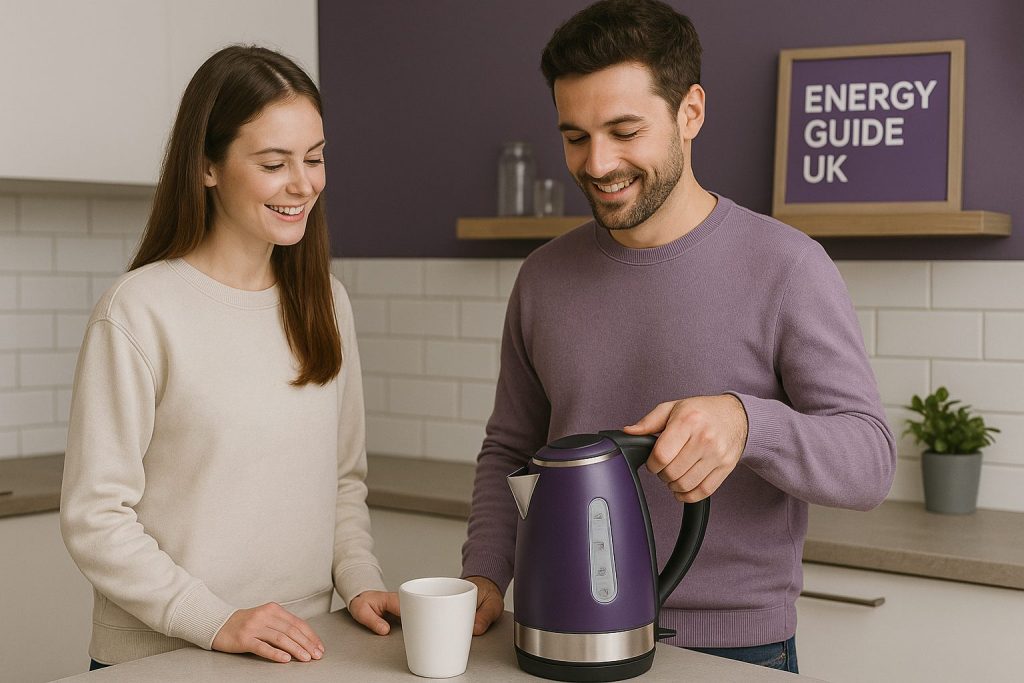
Energy-Efficient Kettles at a Glance:
- Best energy-efficient kettle overall – Bosch Styline TWK8633GB
- Best budget energy-saving kettle – Russell Hobbs 24360
- Best for large households – Morphy Richards Evoke Pyramid Kettle
- Best-looking and quietest Kettle – Swan Nordic Kettle
- Best luxury smart kettle – Smeg KLF04 Variable Temperature Kettle
- Best eco-friendly glass kettle – Kenwood ZJG112CL Persona Glass Kettle
- Best energy-efficient kettle for durability – Dualit Classic Kettle
- Best for solo tea drinkers – Breville HotCup VKT124 Kettle
1. Bosch Styline TWK8633GB
Best energy-efficient kettle overall
What we like: Sleek, quiet, and insulated with variable temperature controls
What we don’t like: Limited colour options
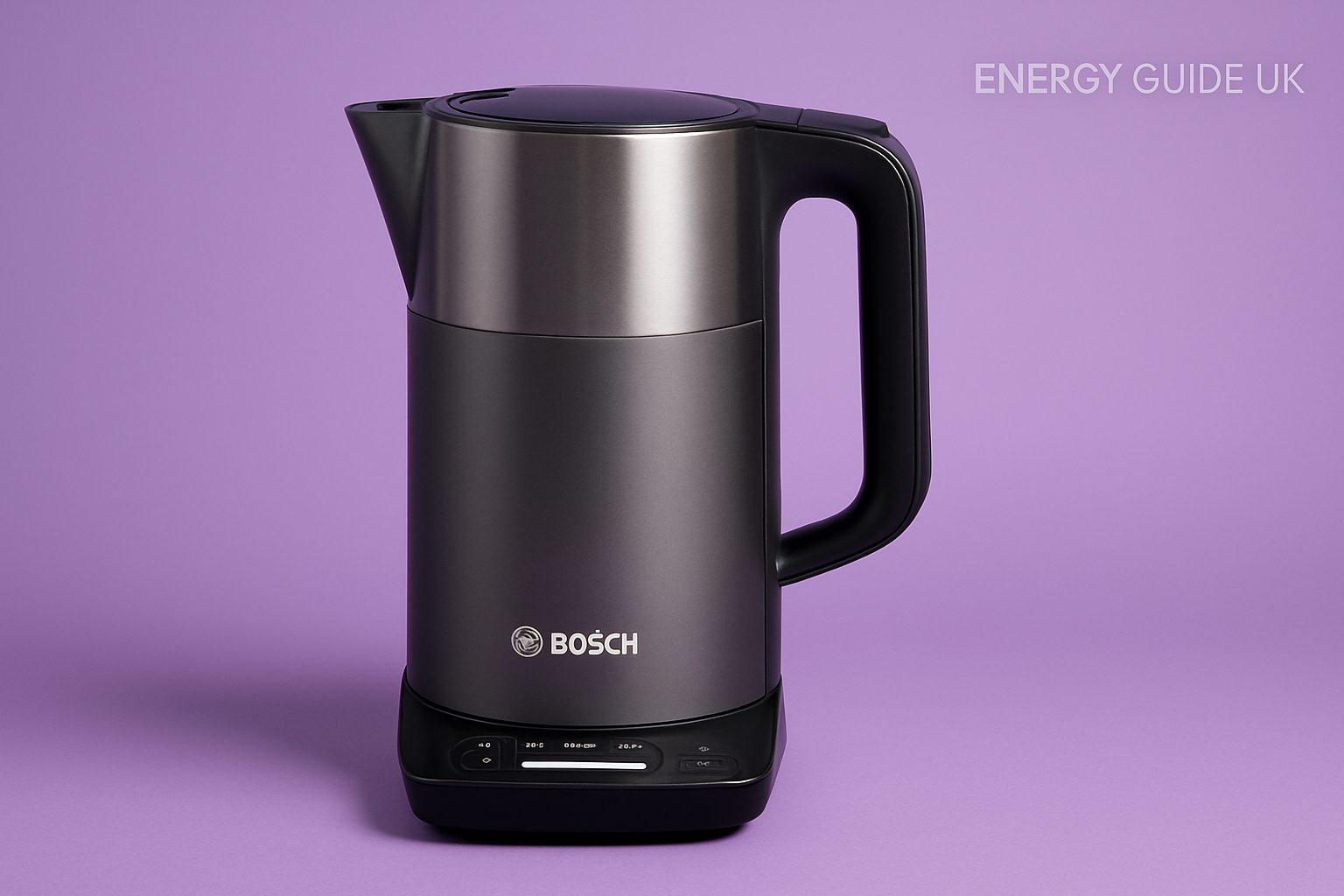
- Boil Time (1L): 2 min 15 sec
- Energy Use: 0.085 kWh
- Noise Level: 48 dB
- Price: ~£79.99
- Best For: Everyday use with optimal efficiency
Bosch has struck an impressive balance with this model: fast, quiet, smart, and efficient. The double-walled insulation keeps water warmer for longer, while the four temperature settings (70°C, 80°C, 90°C, and 100°C) help you avoid unnecessary boiling. That’s a game-changer if you drink green tea or coffee, which only need low temperatures.
It also features a keep-warm function (up to 30 minutes), auto shut-off, and a slick design that doesn’t scream “techy.” This kettle doesn’t just look good — it feels engineered. The preset temperature buttons are a small luxury you’ll use daily.
2. Russell Hobbs 24360
Best budget energy-saving kettle
What we like: Affordable, time and energy-saving
What we don’t like: A bit noisy
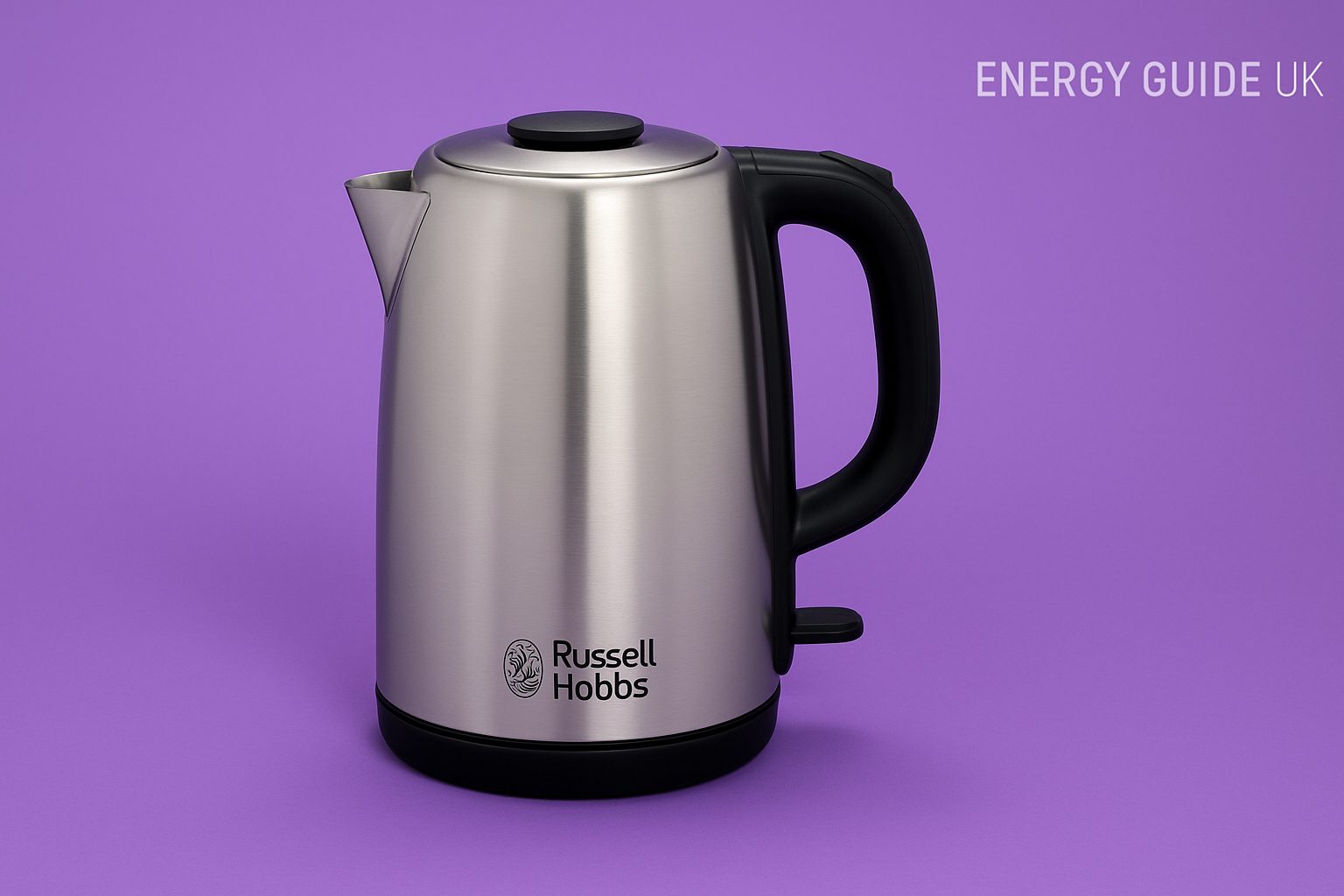
- Boil Time (1L): 2 min 25 sec
- Energy Use: 0.088 kWh
- Noise Level: 54 dB
- Price: ~£34.99
- Capacity: 1.7L
- Best For: Value-conscious buyers looking for everyday efficiency
Don’t let the price fool you — this kettle punches above its weight. The key feature is its rapid boil zone, which lets you boil just one or two cups quickly and efficiently. It’s a bit noisier than more premium models, but it’s lightweight, functional, and ideal for couples or solo drinkers.
It offers a clear, practical benefit for anyone who typically boils one or two cups of water at a time. The 1-cup rapid boil zone heats water in around 45 seconds, saving time and power. It has a removable, washable filter and a water-level indicator. The kettle’s design is functional rather than flashy, with a standard black or stainless-steel look.
For under £40, this is one of the most energy-aware budget kettles on the market.
3. Morphy Richards Evoke Pyramid Kettle
Best for large households
What we like: Classic design and quick boil, even for large fills
What we don’t like: No insulation
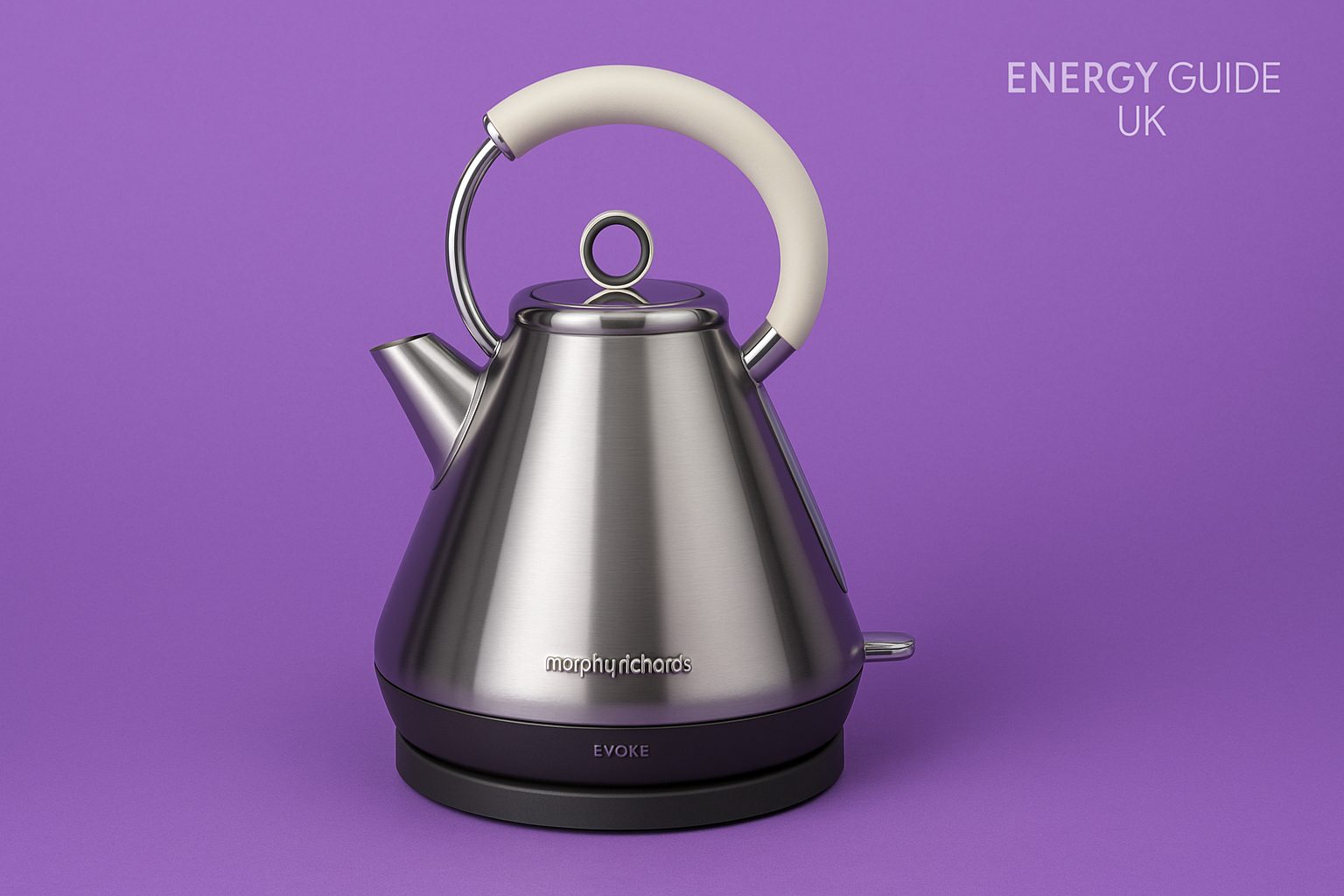
- Boil Time (1L): 2 min 35 sec
- Energy Use: 0.089 kWh
- Noise Level: 50 dB
- Price: ~£59.99
- Capacity: 1.5L
- Best For: Families or frequent tea-makers
This is a stylish and substantial kettle for people who often need more than one or two cups. The pyramid design hides a surprisingly efficient boil with features like a water level gauge, a built-in limescale filter, and a 3kW element for speed.
It offers a classic kettle experience with added convenience through features like a rapid boil, a 1.5-litre capacity, and auto shut-off. Its stainless steel body looks polished, while the 360-degree base keeps usability front and centre. Energy-wise, it’s most efficient when used correctly: don’t overfill, descale monthly, and stick to single-cup boils when possible.
Big, bold, and built for busy households. It won’t waste energy, even when you’re making back-to-back cuppas.
4. Swan Nordic Kettle
Best-looking and quietest Kettle
What we like: Quiet and insulated with a designer look
What we don’t like: Prone to fingerprints on matte finish
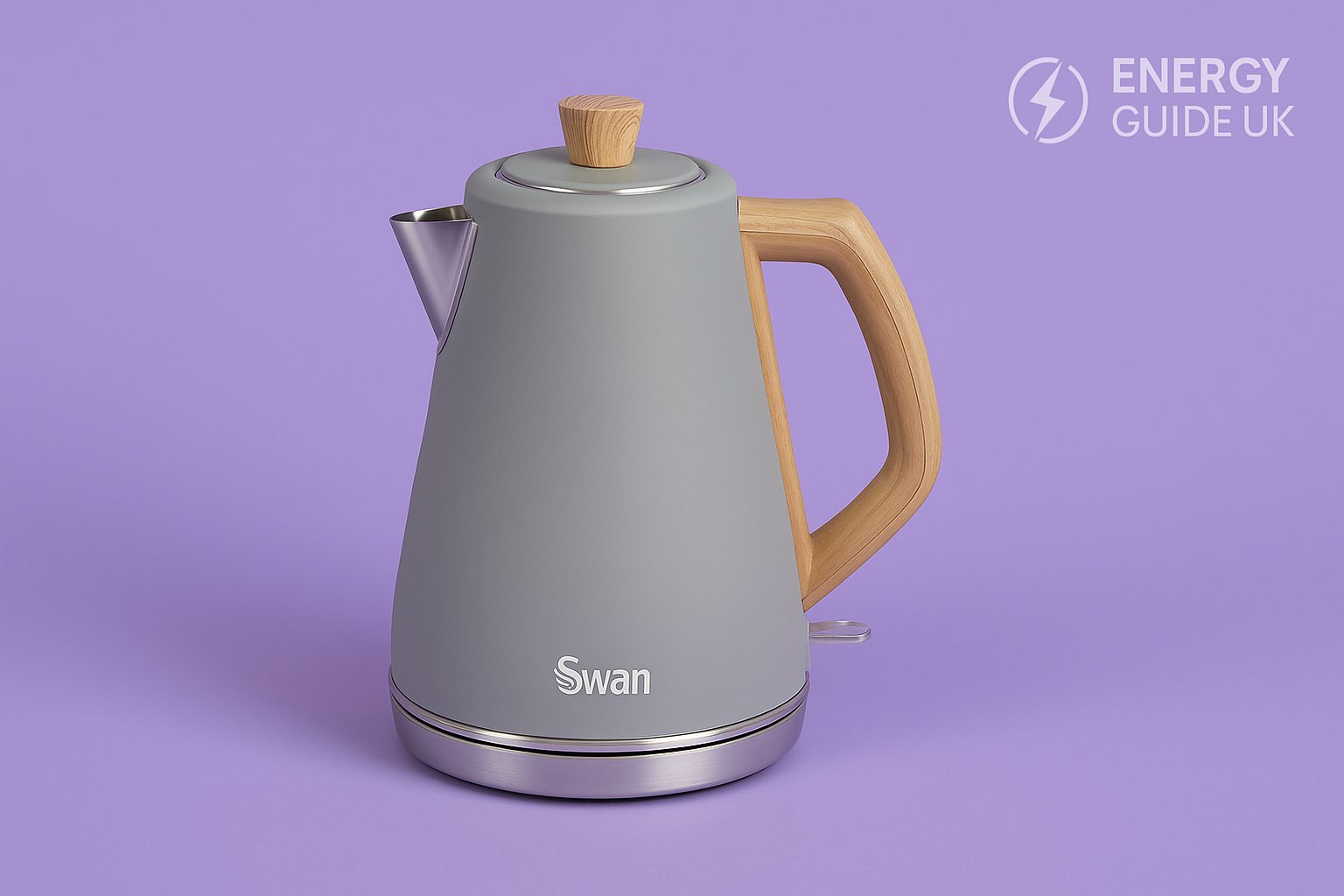
- Boil Time (1L): 2 min 30 sec
- Energy Use: 0.087 kWh
- Noise Level: 47 dB
- Price: ~£49.99
- Capacity: 1.7L
- Best For: Style-focused users who want performance
This kettle doesn’t just look good — it performs. The soft matte finish, wood-effect handle, and minimalist controls make it feel premium without the high price tag. It’s also one of the quietest kettles on the market, making it ideal for open-plan homes.
It features a 1.7-litre capacity and a 3kW heating element for quick boils. A key energy-saving detail is the insulated body, which keeps heat longer than standard designs. That means less need to reboil if you step away for a few minutes. Other practical elements include boil-dry protection and auto shut-off.
It boils quietly and quickly, and the wide lid makes filling and cleaning hassle-free.
Understated, fast, and efficient. A Scandi-style win for anyone who values peace in the kitchen.
5. Smeg KLF04 Variable Temperature Kettle
Best luxury smart kettle
What we like: Keep warm function and iconic retro design
What we don’t like: Pricey
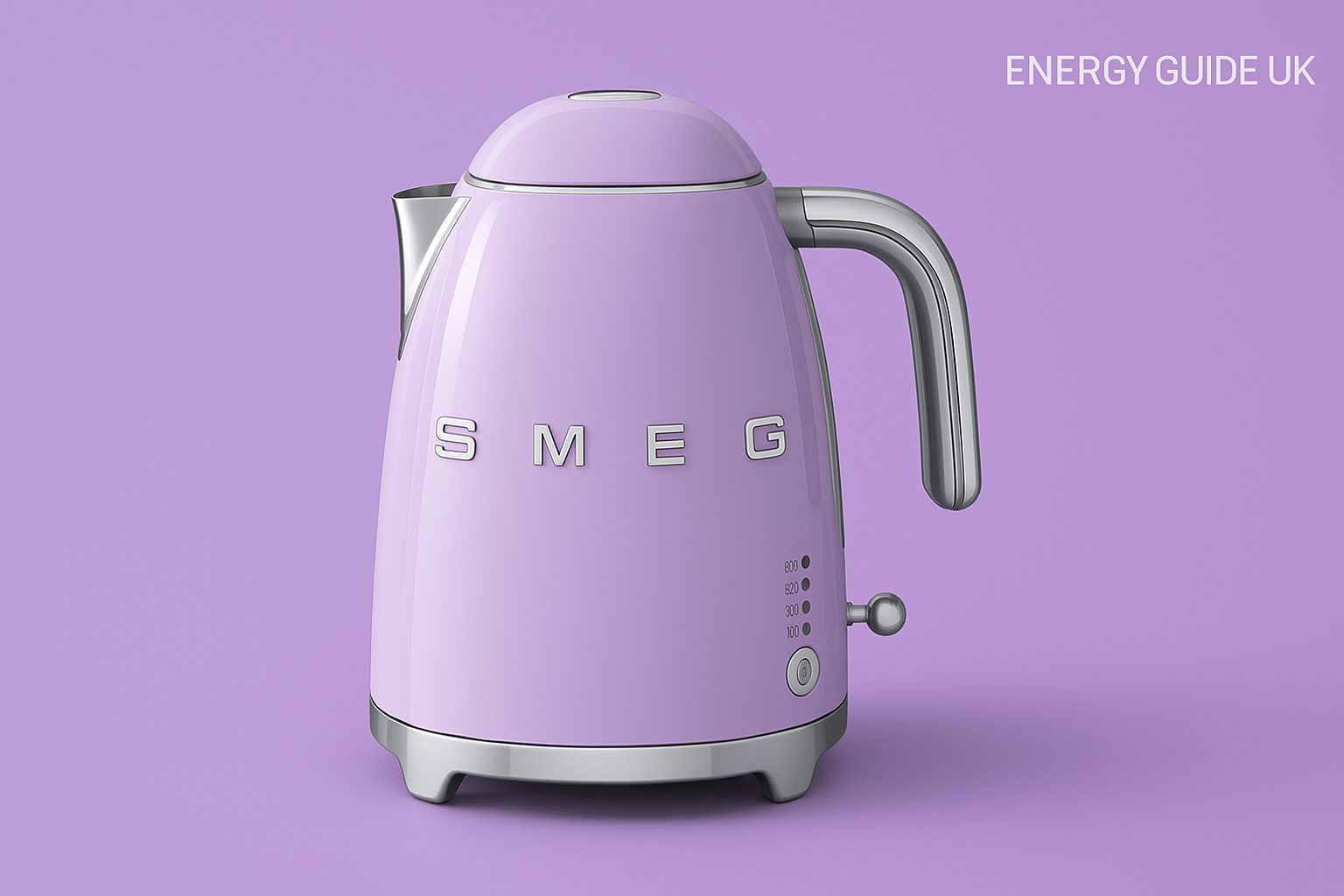
- Boil Time (1L): 2 min 40 sec
- Energy Use: 0.090 kWh
- Noise Level: 52 dB
- Price: ~£149.00
- Capacity: 1.7L
- Best For: Premium buyers who want full control
It’s not cheap, but Smeg’s KLF04 offers the full smart-kettle experience in a retro-modern shell. The variable temperature settings range from 50°C to 100°C, and the automatic shut-off and keep-warm features make it surprisingly energy-savvy.
It has a solid build, a 360-degree base to prevent wobbling, and a soft-open lid. It’s very quiet and the element is hidden, so the base is flat and easy to clean and descale. The spout is non-drip and easy to pour, although it’s fairly small, so you’ll find yourself pouring slowly.
The Smeg doesn’t just make a statement — it stops you from boiling water you don’t need to. Stylish and smart.
6. Kenwood ZJG112CL Persona Glass Kettle
Best eco-friendly glass kettle
What we like: Transparent glass helps prevent overfilling
What we don’t like: No temperature or smart features
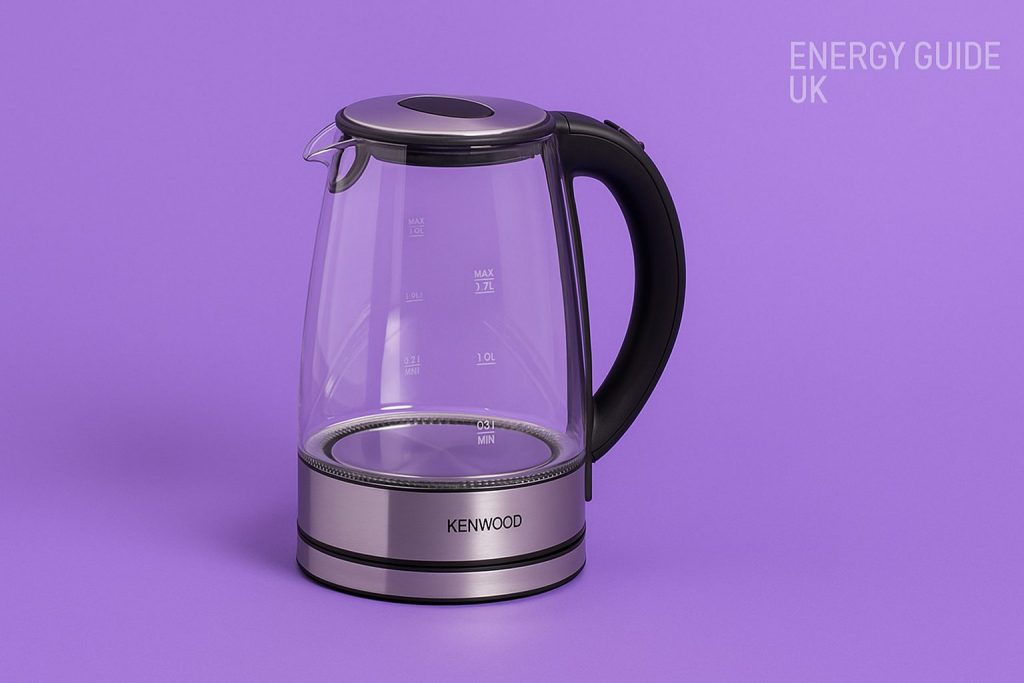
- Boil Time (1L): 2 min 20 sec
- Energy Use: 0.086 kWh
- Noise Level: 49 dB
- Price: ~£64.99
- Capacity: 1.7L
- Best For: Eco-conscious buyers who want visual feedback
This kettle helps you literally see efficiency. The clear glass body means you’re less likely to overfill, and the efficient heating element quickly brings water to a boil. It’s a good balance of sustainability and simplicity.
Its 1.7L capacity suits various needs, from a single cup to multiple servings. The “Eco 1 Cup” feature allows for boiling only the needed amount, conserving energy and reducing waste. Crafted with a heat-resistant glass body, it provides a clear view of the water level, aiding in precise measurements. The flip lid facilitates one-handed operation.
If you tend to overfill your kettle ‘just in case,’ this might fix that habit — and lower your bill.
7. Dualit Classic Kettle
Best energy-efficient kettle for durability
What we like: Iconic design and made to last
What we don’t like: Expensive
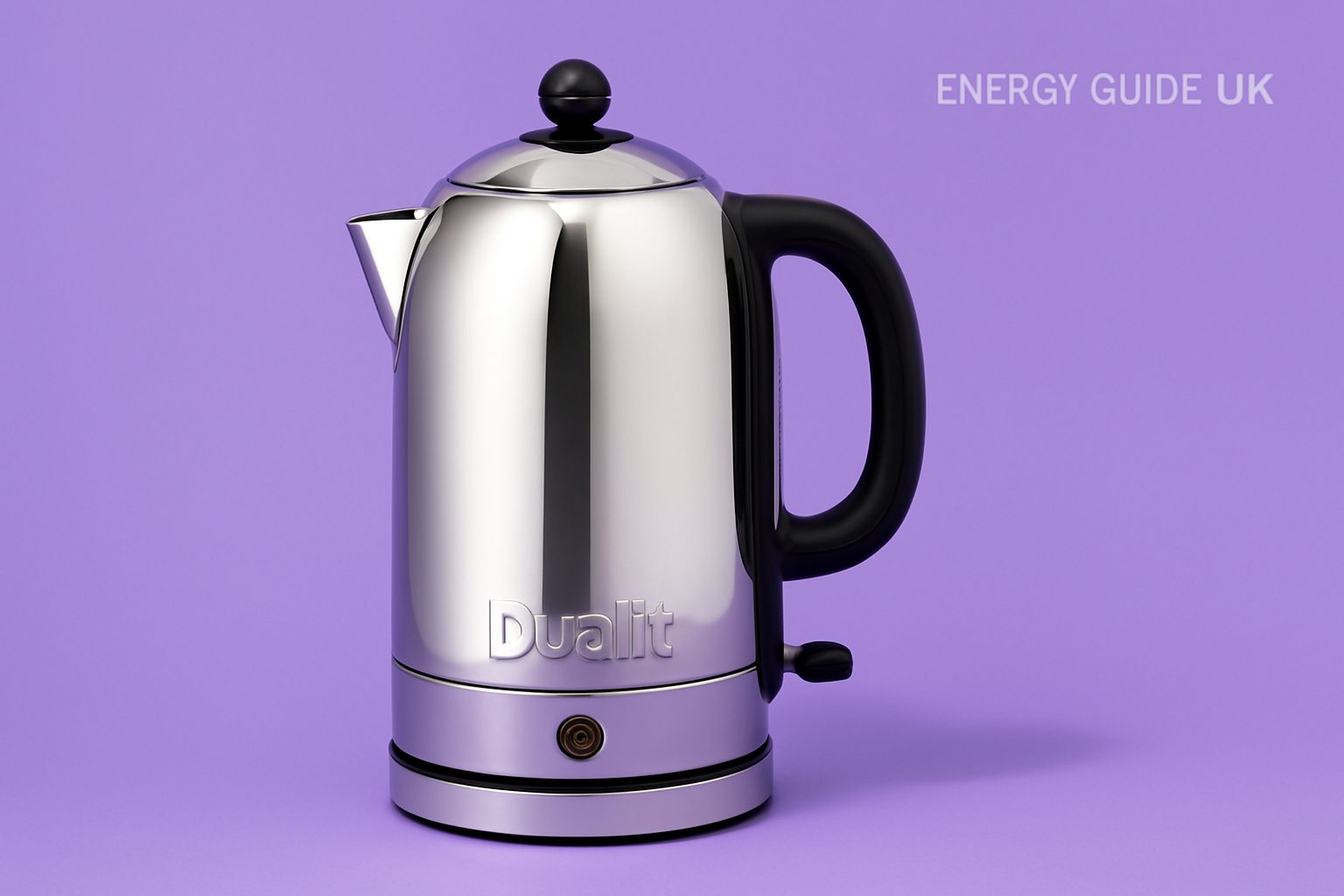
- Boil Time (1L): 2 min 45 sec
- Energy Use: 0.091 kWh
- Noise Level: 55 dB
- Price: ~£149.99
- Capacity: 1.7L
- Best For: Durability and traditional design
The Dualit Classic kettle blends old-school craftsmanship with smart energy use. Known for its stainless-steel body and solid build, this model is made in the UK and features replaceable parts, which are rare in today’s throwaway appliance culture. It heats quickly using a powerful 3kW element but does so efficiently, thanks to its fast boil design.
The wide spout makes pouring precise and drip-free, while the ergonomic handle balances the unit well, even when full. It’s one of the quieter kettles available, with a gentle “whisper boil” that suits open-plan kitchens or early morning use. The 1.7-litre capacity handles group brewing easily, and its classic look makes it a countertop feature rather than something to hide away.
Engineered to last a lifetime, making it the most sustainable choice if you’re playing the long game.
8. Breville HotCup VKT124
Best for solo tea drinkers
What we like: Boils a single cup in under a minute
What we don’t like: Not ideal for larger batches or cooking

- Boil Time (1 Cup): ~40 seconds
- Energy Use: Approximately 0.045 kWh per cup
- Noise Level: Moderate (50–54 dB)
- Price: ~£54.99
- Capacity: 1.7L (up to 8 cups)
- Best For: Quick, single-serve hot drinks with minimal energy waste
The Breville HotCup VKT124 is a stellar choice for individuals or small households seeking speed and efficiency in their hot beverage preparation. Its design focuses on energy conservation without compromising on performance.
Rapid dispensing delivers near-boiling water in approximately 40 seconds, perfect for instant beverages. The user-friendly design features a large water window with blue illumination during boiling, and a removable drip tray to accommodate various cup sizes. It’s equipped with a safety cut-out and non-slip feet for secure operation and only boils the required amount of water, reducing electricity consumption.
Stellar choice for individuals or small households seeking speed and efficiency in their hot beverage preparation.
Energy Efficient Kettle Comparison Table
| Kettle | Boil Time (1L) | Energy Use (kWh) | Noise Level | Price | Best For |
|---|---|---|---|---|---|
| Bosch Styline TWK8633GB | 2:15 | 0.085 | Very Low | £79.99 | All-round performance |
| Russell Hobbs 24360 | 2:25 | 0.088 | Moderate | £34.99 | Budget-conscious buyers |
| Swan Nordic | 2:30 | 0.087 | Very Low | £49.99 | Design lovers |
| Morphy Richards Evoke | 2:35 | 0.089 | Low | £59.99 | Large households |
| Dualit Classic | 2:45 | 0.091 | Moderate | £149.99 | Durability and traditional styling |
| Smeg KLF04 | 2:40 | 0.090 | Moderate | £149.00 | Stylish control + smart features |
| Kenwood ZJG112CL | 2:20 | 0.086 | Low | £64.99 | Eco-aware, minimalist households |
Factors to Consider When Choosing An Energy-Efficient Kettle
Minimum Fill Capacity
One of the simplest ways to save energy is to boil only what you need. Many standard kettles have a minimum fill requirement of 500ml or more, which wastes electricity if you only want a single cup.
Energy-efficient models often allow boiling as little as 250ml. This is especially helpful for solo users or people who make multiple cups daily.
Boiling Speed
Boiling speed matters when it comes to saving both energy and time. A fast-boil kettle can heat water for one cup in 45–60 seconds, using less electricity overall and saving you money on your bill.
A high-powered kettle used for single-cup boils will consume less energy per use than a slower kettle used inefficiently. Faster boiling not only lowers bills but adds convenience to busy routines.
Temperature Control
Kettles with variable temperature control allow you to set precise temperatures instead of always boiling to 100°C. This feature is perfect for tea lovers, coffee drinkers, and anyone preparing formula or delicate drinks.
Heating water only to 70°C or 90°C, rather than boiling unnecessarily, can result in meaningful energy savings over time. Models with digital displays or preset buttons (e.g., 70°C, 80°C, 90°C, and 100°C) offer both accuracy and ease.
Keep-Warm Function
A keep-warm function maintains your selected temperature for up to 30 minutes without reboiling. While it does use electricity, it’s more efficient than reheating cold water multiple times a day. This feature suits those who make back-to-back drinks or work from home and want hot water ready without waiting.
Look for models with insulated bodies, as they complement this function by reducing heat loss. Some advanced kettles only activate keep-warm when necessary, further improving energy use.
Insulation / Double Wall Design
Insulated kettles retain heat better than traditional single-walled models. The double-wall construction helps keep the water hot longer, preventing repeat boiling and improving safety since the outside remains cool. This feature is excellent for families or shared households where people boil water at staggered times.
It also enhances efficiency in kettles with keep-warm functions. Over time, insulation can lead to noticeable savings on energy bills, especially in homes where the kettle is used heavily throughout the day.
Auto Shut-Off and Boil-Dry Protection
These built-in safety features double as energy-saving tools. Auto shut-off turns the kettle off immediately after the water reaches a boil, preventing overheating and wasted electricity. Boil-dry protection stops the kettle from operating when empty, which can cause damage and unnecessary energy use.
Both functions are standard in most modern kettles, but worth checking for in budget models. They protect the kettle, improve its longevity, and help prevent forgetting to turn it on. An energy-efficient kettle should always have both.
Material and Build Quality
Stainless steel kettles often outperform plastic or glass models in terms of heat retention and durability. Their better build quality retains heat longer, reducing repeat boils. The appliance also lasts for years, reducing your long-term environmental impact.
Thicker walls and well-fitted lids also help prevent heat from escaping. Cheaper kettles may warp, leak, or fail quickly, leading to replacement and added cost. A sturdy build supports energy efficiency in daily use and across the kettle’s lifespan.
Ease of Measuring Water
Overfilling is one of the most common causes of wasted kettle energy. Choosing a model with a clear water-level window and precise cup indicators helps solve that. Some models even mark specific cup levels like “1”, “2”, or “3” to simplify daily use.
Digital kettles might display the exact volume remaining or let you set a precise amount to boil. Measuring accurately keeps electricity use in check and speeds up boil times. A kettle that’s easy to read is more likely to be used efficiently.
Size and Capacity
The right kettle size depends on your household needs. A 1.0 to 1.5-litre model is typically more efficient for one or two people. Larger families or offices may benefit from a 1.7-litre kettle, provided you use it correctly. Overfilling “just in case” wastes energy.
One-cup dispensers are great for individuals making drinks throughout the day. Consider whether your usage pattern suits a high-capacity model or something compact. Bigger isn’t always better regarding energy savings, especially if you’re only boiling for one.
User Reviews and Testing
User reviews and independent testing give valuable insight into how energy-efficient a kettle is in daily use. Look for mentions of boil time, minimum fill accuracy, noise levels, and build durability.
Reviews help separate marketing from reality. A kettle with impressive specs may fall short in real-world use. Issues like frequent reboiling, faulty sensors, or slow heating times can cancel any claimed efficiency.
Energy-Saving Tips for Using Your Kettle
No matter which kettle you buy, you can make it even more efficient with these tips:
- Only boil what you need. Don’t fill to the max if you’re just making one cup.
- Descale regularly. Limescale buildup reduces heating efficiency.
- Use lower temperatures. 70°C is fine for green tea or coffee; boiling to 100°C is often unnecessary.
- Keep it clean. A clean kettle performs better and lasts longer.
- Unplug when not in use. Avoid trickle draw from kettles with digital displays or lights.
Frequently Asked Questions on the Best Kettles UK
How long does water stay hot in a kettle?
It depends on the type of kettle. Standard single-walled kettles lose heat quickly — water can cool down noticeably within 15–30 minutes. In contrast, double-walled or insulated kettles (like the Bosch Styline) can keep water warm for up to 1 hour. Some smart kettles include a keep-warm function that maintains temperature for 20–60 minutes using minimal energy.
To maximise heat retention:
- Choose kettles with double-wall insulation
- Use a kettle cover or cosy
- Don’t open the lid after boiling if you’re planning to use the water shortly
Does boiling a full kettle save electricity?
Only if you need all the water. A kettle full of water uses more energy to boil than a cup or two, simply because it takes longer to heat a larger volume of water. Unless you’re using it all in one go (e.g., for a teapot or cooking), boil only what you need. Some kettles, like the Russell Hobbs 24360, feature “rapid boil zones” that allow you to fill just enough for one or two cups—perfect for saving time and power and reducing electric bills.
How do you descale a kettle?
Limescale builds up from hard water and can reduce your kettle’s efficiency and lifespan. Here’s how to descale it safely:
Using white vinegar:
- Fill the kettle with a mixture of 1 part vinegar to 1 part water.
- Boil the solution and let it sit for 30–60 minutes.
- Rinse thoroughly and boil clean water once or twice to remove any vinegar residue.
With lemon juice:
You can also use lemon juice (fresh or bottled) as a natural alternative.
Using descaling tablets:
Many brands sell descaling sachets or tablets, and you only need to follow the product instructions.
Tip:
Depending on your local water hardness, try to descale your kettle every 1–3 months.
How often should you replace a kettle?
The average kettle lasts 3 to 5 years, but it depends on how often you use it and how well you maintain it. Signs it may be time to replace your kettle:
- It takes longer to boil
- Strange noises or smells
- The lid or switch is faulty
- Heavy limescale build-up that won’t clean out
- It no longer shuts off automatically
Higher-end models like the Dualit Classic or Smeg KLF04 may last longer due to their build quality and replaceable parts. But for any kettle, regular descaling and avoiding overfilling will help extend its life.
How much energy do kettles use?
Briefs used to inform government decisions show that kettles consume approximately 4.2 tWh of electricity annually in the UK. Various factors will determine the amount of energy your kettle uses, including the model’s energy efficiency rating and the number of litres of water it can hold.
The kettle is one of the appliances that uses the most power due to its high wattage, requiring the highest current when switched on. One study successfully recorded the energy profile of the electric kettle and found it consumed around 1500 watts of electric energy in the boiling state.
Why do kettles use so much energy?
Electric kettles account for a large proportion of energy use, mainly because of how people use them.
Many people overfill their kettles and boil much more water than they require. In 2022, the UKTIA quizzed 1,000 UK tea drinkers and found that eight in 10 Brits waste energy by overfilling the kettle when making a cup.
A survey by the Energy Savings Trust of 86,000 households in the UK found that three out of four respondents boil more water in the kettle than they need, which costs an estimated £68 million on energy bills a year.
The trick is only to boil the volume of water you need, so how do you ensure you do this?
Thankfully, there are kettles designed to help you easily boil the water volume you need at any time.
Which is the best energy-saving kettle in the UK?
Some of the best energy-saving kettles in the UK are eco kettles.
Research shows that, on average, eco kettles or energy-efficient kettles can save 30% of energy compared to regular kettles and habits if you follow the instructions for the kettle.
You can also double-check and ensure that your kettle includes the following features:
- A low minimum fill level
- A kettle that switches off immediately after boiling
These two features mean that the kettle will not end up boiling more water than you need.
For illustration, according to the Energy Savings Trust, avoiding overfilling your kettle can save you £10 a year in GB and £12 in NI on your electricity bill.
How do Energy-Efficient Kettle Ratings Work?
The energy label rating system was launched in the UK over 20 years ago.
The system helps to indicate how much energy appliances like kettles use during operation.
The rating system has a scale from A to G, with A being the most efficient and G the least efficient.
The general rule is that the system categorises appliances by their size.
In short, this means that two different-sized appliances with the same energy rating may have different running costs.
Do fast, energy-efficient kettles use more energy?
No, this is not true and is simply a myth.
An eco-friendly kettle that can boil water faster will typically use less energy/electricity than a kettle that takes longer to boil the water.
With that in mind, when choosing between kettles that heat at different speeds and your main goal is to use less energy, choose the kettle that boils water faster.
How can you save money when using your kettle?
If you want to save as much money as possible when boiling water, follow these main rules:
- Do not boil your water on the hob – instead of your kettle, this typically costs more as it takes longer to reach a boil.
- Boil only the water you require – only boil the volume of water you need. Overfilling the kettle is one of the major causes of high energy consumption.
- Choose a kettle with a low minimum fill level – This will help you easily see and limit the volume of water you need to boil.
Sources and References
-
- https://www.sciencedirect.com/science/article/pii/S0306261916303579#b0005
-
- https://www.sciencedirect.com/science/article/pii/S0306261914011623?via%3Dihub
-
- https://heatable.co.uk/boiler-advice/how-much-energy-do-appliances-use
-
- https://www.tea.co.uk/news/article/the-tea-riffic-hack-that-can-cut-the-nations-energy-bill-by-nearly-800000-a-year#_ftn1
-
- https://energysavingtrust.org.uk/sites/default/files/reports/AtHomewithWater%287%29.pdf
-
- https://www.eco-logisch.nl/pdfupload/Rapport_ecokettle (engels).pdf
- https://www.researchgate.net/publication/330467093_Design_of_an_IoT_Energy_Monitoring_System
- https://energysavingtrust.org.uk/top-five-energy-consuming-home-appliances/